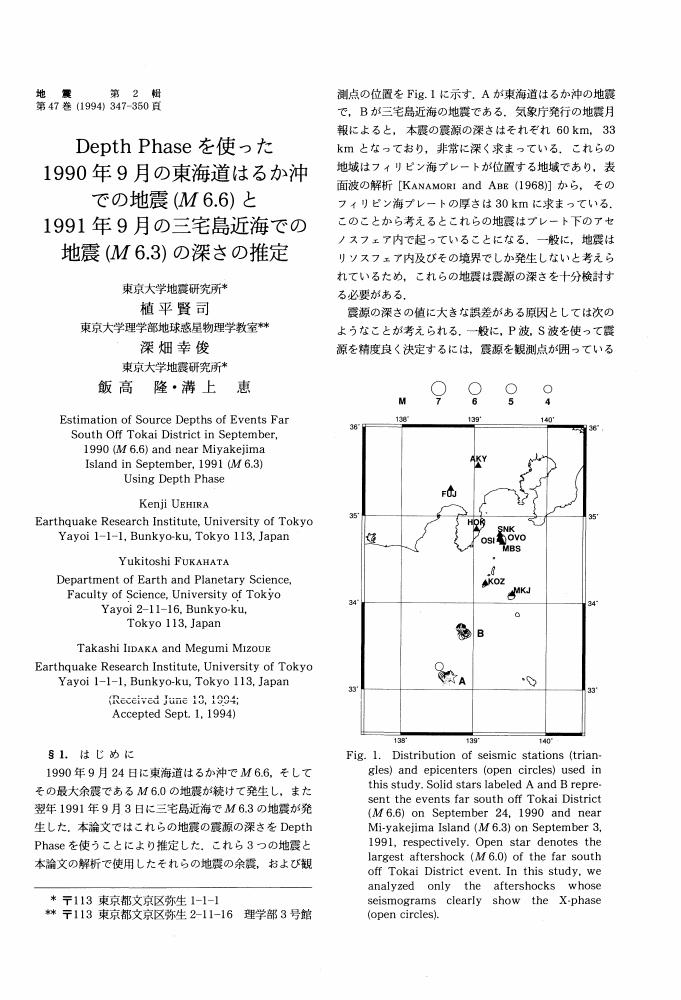3 0 0 0 OA 地震学における ABIC を用いたインバージョン解析研究の進展
- 著者
- 深畑 幸俊
- 出版者
- 公益社団法人 日本地震学会
- 雑誌
- 地震 第2輯 (ISSN:00371114)
- 巻号頁・発行日
- vol.61, no.Supplement, pp.103-113, 2009-07-31 (Released:2013-11-21)
- 参考文献数
- 64
- 被引用文献数
- 2 7
Inversion analyses play a central role in solid earth sciences, since observable quantities are very limited for the earth’s interior. Classical least squares method does not work well in these fields, since observed data are commonly inaccurate and/or insufficient. Least squares methods with additional conditions, such as damping or smoothing, have been widely used, but the weight of damping or smoothing have to be manually adjusted, if we do not take in a probabilistic point of view. In 1980, H. Akaike proposed a Bayesian Information Criterion (ABIC), where smoothness constraint is regarded as prior information that is combined with information from observed data by Bayes’ rule, and then the optimal weight between the information from observed data and prior constraint is objectively determined by minimizing ABIC. ABIC had been introduced to geophysics by several studies. Among them, Yabuki and Matsu’urea (1992) has been the most influential. The inverse method developed by them has been widely applied to various problems in seismology and geodesy. Recently, it has become clear that the inverse method must be further developed beyond the framework given by Yabuki and Matsu’ura (1992). Generalization has been performed in dealing with prior constraints, hyperparameters, and observed data.
1 0 0 0 OA 特集号「地殻ダイナミクス(Part I)—主としてマクロな視点から—」巻頭言
- 著者
- 深畑 幸俊 大橋 聖和 高田 陽一郎 田中 明子
- 出版者
- 公益社団法人 東京地学協会
- 雑誌
- 地学雑誌 (ISSN:0022135X)
- 巻号頁・発行日
- vol.128, no.5, pp.685-687, 2019-10-25 (Released:2019-11-15)
- 参考文献数
- 9
- 被引用文献数
- 2
1 0 0 0 OA 地震学的データを用いた応力インバージョン
- 著者
- 岩田 貴樹 吉田 圭佑 深畑 幸俊
- 出版者
- 公益社団法人 東京地学協会
- 雑誌
- 地学雑誌 (ISSN:0022135X)
- 巻号頁・発行日
- vol.128, no.5, pp.797-811, 2019-10-25 (Released:2019-11-15)
- 参考文献数
- 49
- 被引用文献数
- 10
In order to understand crustal dynamics, including the occurrence of earthquakes and the development of mountain ranges, it is important to estimate the stress state in the Earth's crust from observed data. This paper reviews stress tensor inversion techniques using seismological data. The techniques were originally applied to a dataset of slip orientations taken from focal mechanisms. Subsequently, other techniques, which use P wave first-motion polarities or centroid moment tensor (CMT) solutions, were developed. This paper clarifies the principles and basic hypotheses, on which each technique is built. In the techniques using focal mechanisms and P wave first-motion data, the Wallace–Bott hypothesis that a fault slips in the direction of maximum resolved shear stress plays the principal role; basically, we search for a stress state that satisfies observed data on the basis of the Wallace–Bott hypothesis. On the other hand, the stress inversion technique using CMT data is not based on the Wallace–Bott hypothesis; instead, it is assumed that stress released by earthquakes is proportional to the stress tensor in the region surrounding the hypocenter. The characteristics and advantages of these techniques are also compared from physical and pragmatic viewpoints. It would be valuable to further improve these techniques, as well as to compare their performance using synthetic and actual data to clarify the differences and advantages of their characteristics in more detail.
1 0 0 0 IR ニュージーランド南島北部における地震観測
- 著者
- 三浦 勉 飯尾 能久 SIBSON Richard H. 岡田 知己 松本 聡 PETTINGA Jarg BANISTER Stephen 平原 聡 中山 貴史 中元 真美 山田 真澄 大見 士朗 米田 格 濱田 勇輝 高田 陽一郎 深畑 幸俊 小菅 正裕 TOWNEND John REYNERS Martin GHISETTI Francesca C.
- 出版者
- 京都大学防災研究所
- 雑誌
- 京都大学防災研究所年報. B = Disaster Prevention Research Institute Annuals. B (ISSN:0386412X)
- 巻号頁・発行日
- vol.57, pp.94-101, 2014-06
We observe the seismic activity in the northern part of the South Island in New Zealand since Nov. 2009. New Zealand is located at the border between the Pacific plate and the Australian plate and the Alpine Fault runs along the boundary from southwest to northeast in the South Island. A lot of earthquakes occurred there, e.g., 1929 Murchison (M7.7), and 1968 Inanghua (M7.2). We observed aftershocks of the 2011 Christchurch earthquake for 2 years since Mar. 2011. Now, We expand the observation network with about 40 seismometers in northern part of the South Island.
- 著者
- 植平 賢司 深畑 幸俊 飯高 隆 溝上 恵
- 出版者
- 公益社団法人 日本地震学会
- 雑誌
- 地震 第2輯 (ISSN:00371114)
- 巻号頁・発行日
- vol.47, no.3, pp.347-350, 1994-10-14 (Released:2010-03-11)
- 参考文献数
- 4
1 0 0 0 OA 線形粘弾性問題の時間無限大の解
- 著者
- 深畑 幸俊
- 出版者
- 一般社団法人日本応用数理学会
- 雑誌
- 応用数理 (ISSN:09172270)
- 巻号頁・発行日
- vol.19, no.2, pp.84-96, 2009-06-25
- 被引用文献数
- 1
粘弾性の問題を取り扱う際に対応原理がよく用いられる.本稿では,対応原理にラプラス変換の最終値定理を併せて用いることで,粘性緩和完了後の解などが煩雑な粘弾性の計算を経ずに,弾性問題の解から直接に得られることを示す.


